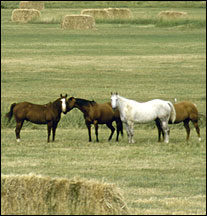WILD HORSES
article by: Rebecca Dias
 Spanish explorers brought horses to North America in the late fifteenth century. Whether horses existed there before that time or not is a hotly debated subject. Native Americans used horses throughout the Great Plains and the West. A journal of Peter Ogden, written in 1828, talks of finding and capturing wild horses. As recently as the 1950's, horses were released by formers, ranchers, miners, and the US cavalry onto public lands. Shires, Percherons, Morgans, Hambletonians, and Irish stallions and mares were released in order to create standards and patterns in the wild horse population. The horses were trapped and trained whenever the cavalry, miners, or ranchers needed them.
Spanish explorers brought horses to North America in the late fifteenth century. Whether horses existed there before that time or not is a hotly debated subject. Native Americans used horses throughout the Great Plains and the West. A journal of Peter Ogden, written in 1828, talks of finding and capturing wild horses. As recently as the 1950's, horses were released by formers, ranchers, miners, and the US cavalry onto public lands. Shires, Percherons, Morgans, Hambletonians, and Irish stallions and mares were released in order to create standards and patterns in the wild horse population. The horses were trapped and trained whenever the cavalry, miners, or ranchers needed them.
In Nevada in the 1950's, Velma B Johnston, also known as "Wild Horse Annie", spearheaded a grass roots campaign with school children to save the wild horses from exploitation and cruelty. It created such an outcry from the public that legislation was passed to manage, control, and protect the horses. Former President Richard M. Nixon signed into law the Wild Free-Roaming Horses and Burros Act of 1971.
 Today, wild horses roam free on public land in Nevada administered by the Bureau of Land Management (BUM). The Nevada Wild Horse Range in Nye County has 394,000 acres designated primarily for the wild horses. Over 27,000 horses live on public lands administered by the BLM's Winnemucca, Battle Mountain, Carson City, and Las Vegas Districts.
Today, wild horses roam free on public land in Nevada administered by the Bureau of Land Management (BUM). The Nevada Wild Horse Range in Nye County has 394,000 acres designated primarily for the wild horses. Over 27,000 horses live on public lands administered by the BLM's Winnemucca, Battle Mountain, Carson City, and Las Vegas Districts.
Every year, the BLM gathers some of the horses off the ranges and puts them up for adoption to the public. Strict regulations are in force to ensure the horses' well-being whenever they are adopted.


 Spanish explorers brought horses to North America in the late fifteenth century. Whether horses existed there before that time or not is a hotly debated subject. Native Americans used horses throughout the Great Plains and the West. A journal of Peter Ogden, written in 1828, talks of finding and capturing wild horses. As recently as the 1950's, horses were released by formers, ranchers, miners, and the US cavalry onto public lands. Shires, Percherons, Morgans, Hambletonians, and Irish stallions and mares were released in order to create standards and patterns in the wild horse population. The horses were trapped and trained whenever the cavalry, miners, or ranchers needed them.
Spanish explorers brought horses to North America in the late fifteenth century. Whether horses existed there before that time or not is a hotly debated subject. Native Americans used horses throughout the Great Plains and the West. A journal of Peter Ogden, written in 1828, talks of finding and capturing wild horses. As recently as the 1950's, horses were released by formers, ranchers, miners, and the US cavalry onto public lands. Shires, Percherons, Morgans, Hambletonians, and Irish stallions and mares were released in order to create standards and patterns in the wild horse population. The horses were trapped and trained whenever the cavalry, miners, or ranchers needed them.
 Today, wild horses roam free on public land in Nevada administered by the Bureau of Land Management (BUM). The Nevada Wild Horse Range in Nye County has 394,000 acres designated primarily for the wild horses. Over 27,000 horses live on public lands administered by the BLM's Winnemucca, Battle Mountain, Carson City, and Las Vegas Districts.
Today, wild horses roam free on public land in Nevada administered by the Bureau of Land Management (BUM). The Nevada Wild Horse Range in Nye County has 394,000 acres designated primarily for the wild horses. Over 27,000 horses live on public lands administered by the BLM's Winnemucca, Battle Mountain, Carson City, and Las Vegas Districts.


